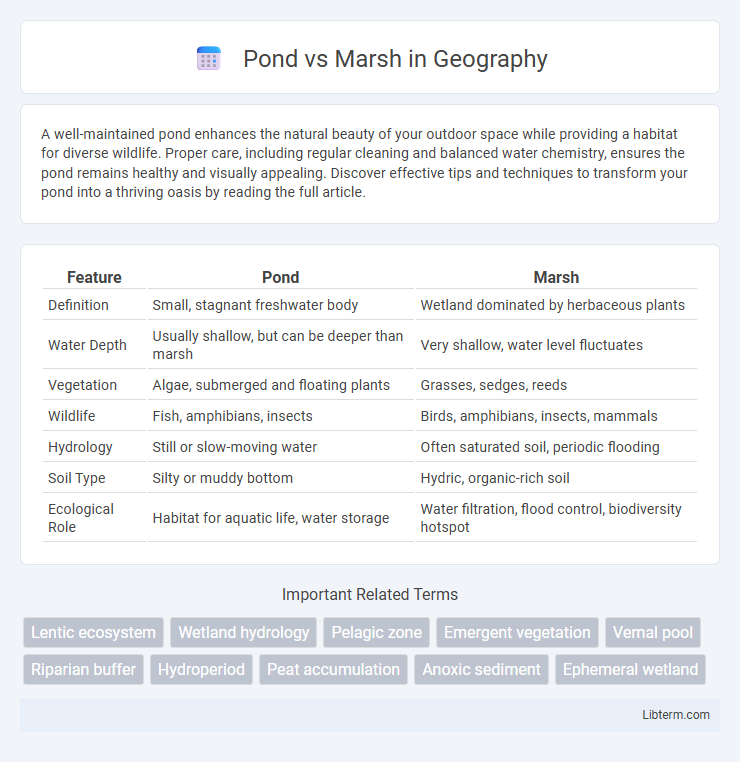A well-maintained pond enhances the natural beauty of your outdoor space while providing a habitat for diverse wildlife. Proper care, including regular cleaning and balanced water chemistry, ensures the pond remains healthy and visually appealing. Discover effective tips and techniques to transform your pond into a thriving oasis by reading the full article.
Table of Comparison
| Feature | Pond | Marsh |
|---|---|---|
| Definition | Small, stagnant freshwater body | Wetland dominated by herbaceous plants |
| Water Depth | Usually shallow, but can be deeper than marsh | Very shallow, water level fluctuates |
| Vegetation | Algae, submerged and floating plants | Grasses, sedges, reeds |
| Wildlife | Fish, amphibians, insects | Birds, amphibians, insects, mammals |
| Hydrology | Still or slow-moving water | Often saturated soil, periodic flooding |
| Soil Type | Silty or muddy bottom | Hydric, organic-rich soil |
| Ecological Role | Habitat for aquatic life, water storage | Water filtration, flood control, biodiversity hotspot |
Introduction to Pond and Marsh Ecosystems
Pond ecosystems are small, still bodies of freshwater that support diverse aquatic plants, algae, and animal species adapted to calm, nutrient-rich environments. Marsh ecosystems consist of wetlands dominated by herbaceous plants like cattails and reeds, providing critical habitats for waterfowl, amphibians, and invertebrates. Both ponds and marshes play vital roles in nutrient cycling, water purification, and flood control, contributing to biodiversity and ecological balance.
Defining Ponds: Characteristics and Features
Ponds are small, shallow bodies of freshwater with still water, often supporting diverse aquatic plants and animals due to ample sunlight penetration. They typically have a distinct boundary separating them from surrounding land and maintain water levels through precipitation, groundwater, or surface runoff. Unlike marshes, ponds usually have clearer water and less emergent vegetation, making them vital habitats for amphibians, fish, and invertebrates.
Understanding Marshes: Key Traits and Functions
Marshes are wetland ecosystems characterized by water-saturated soils and dominated by herbaceous plants such as grasses, reeds, and sedges, differing from ponds, which are standing bodies of water with open surfaces. These habitats play crucial roles in water filtration, flood control, and providing breeding grounds for diverse wildlife including amphibians, birds, and insects. Marshes also act as carbon sinks, aiding in climate regulation by capturing and storing significant amounts of carbon dioxide.
Differences in Water Sources and Depth
Ponds typically have freshwater sources with a consistent water supply from springs, streams, or rainwater, resulting in stable water levels, while marshes often receive water from surface runoff or periodic flooding, causing fluctuating conditions. Ponds are generally deeper, often exceeding 6 feet, allowing for stratification of temperature and oxygen, whereas marshes are shallow wetlands rarely exceeding 3 feet in depth, supporting emergent vegetation. These differences influence the types of flora and fauna each habitat supports, with ponds favoring aquatic species adapted to stable water and marshes supporting plants tolerant of water level changes.
Biodiversity: Flora and Fauna Comparison
Ponds support diverse aquatic plants such as water lilies and algae, while marshes are dominated by emergent vegetation like cattails and reeds, creating varied habitats for wildlife. Ponds typically host amphibians, fish, and insect larvae, whereas marshes offer critical breeding grounds for waterfowl, amphibians, and numerous invertebrates. The varying water levels and plant structures in marshes result in richer biodiversity compared to the usually more stable, open-water environment of ponds.
Ecosystem Services Provided by Ponds and Marshes
Ponds and marshes offer vital ecosystem services including water filtration, habitat provision, and carbon sequestration. Ponds support diverse aquatic species and enhance groundwater recharge, while marshes act as natural flood buffers and nutrient sinks, improving water quality. Both ecosystems play crucial roles in sustaining biodiversity and regulating local climates through their unique hydrological functions.
Human Impact: Threats and Conservation
Human activities such as urban development, agriculture, and pollution significantly threaten ponds and marshes by altering water quality and habitat structure. Marshes, often more vulnerable due to their role in flood control and water filtration, face drainage and land reclamation pressures that reduce biodiversity. Conservation efforts emphasize protecting water sources, restoring native vegetation, and implementing buffer zones to mitigate runoff and sustain ecosystem services.
Role in Flood Control and Water Purification
Marshes play a crucial role in flood control by absorbing excess rainfall and slowing runoff, which reduces the severity of floods. They also act as natural water purifiers, filtering pollutants and trapping sediments before water enters larger bodies. Ponds contribute less to flood mitigation but help in water purification by providing a habitat for microorganisms that break down contaminants.
Recreational and Educational Values
Ponds offer diverse recreational activities such as fishing, birdwatching, and kayaking, providing accessible environments for nature-based education and hands-on learning about freshwater ecosystems. Marshes support ecological education by showcasing wetland habitats critical for wildlife, especially migratory birds and amphibians, while facilitating guided tours and wildlife observation. Both ecosystems enhance environmental awareness, but ponds generally provide more direct recreational opportunities due to easier access and controlled water conditions.
Conclusion: Choosing Between Pond and Marsh Conservation
Pond conservation is ideal for preserving aquatic biodiversity and supporting recreational or aesthetic uses, while marsh conservation excels in providing critical ecosystem services such as water filtration, flood control, and habitat for diverse wetland species. Selecting between pond and marsh conservation depends on specific ecological goals, land availability, and water management needs, with marshes often prioritized for their role in climate resilience and nutrient cycling. Effective conservation strategies integrate both habitats to maximize environmental benefits and sustain ecosystem health.
Pond Infographic

 libterm.com
libterm.com